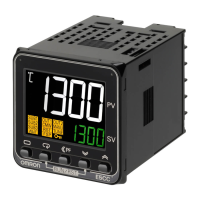Simplicity on the Worksite Solutions Guide for FAQs: E5CC/E5EC
Setting Temperature Alarms
4-2
Setting Temperature Alarms
Select from the
table on page 4-3.
Do you need to
link the alarm
temperature to
the set point?
2.
●Alarm linked to the set point
Linked
Alarm point
Set this difference.
SP
●Alarm not linked to the set point
Fixed
Alarm point
The actual temperature
at which the alarm is
output is set.
0
→
→
If the set point is changed, the set
value of the alarm will also change.
Set the difference
(deviation)
between the set
point and alarm
point.
Set the absolute
temperature at
which the alarm is
output.
Select from the
table on page 4-3.
●Alarm not required when the power is turned ON
Power ON
Time
Example:
Alarm point for
lower-limit alarm
Lower-limit alarm
Temperature is below alarm point, but alarm output
does not turn ON.
Temperature
Alarm output turns
ON second time
temperature goes
below alarm point.
●Alarm also required when power is turned ON
Power ON
Time
Example:
Alarm point for
lower-limit alarm
Lower-limit
alarm output
Alarm output turns ON because temperature is
below alarm point when power turns ON.
Temperature
→
→
Standby
Sequence
No
Standby
Sequence
Do you need
an alarm when
the power is
turned ON?
3.
What Is a Standby
Sequence For?
Particularly with a
lower-limit alarm, the
temperature is often below
the alarm point when
temperature control is
started. In this case, an
alarm would be output at
the start of operation. To
prevent this, a standby
sequence is used to disable
the first alarm.
In the default settings, the standby sequence is restarted (and
the alarm is turned OFF) when operation is started, when the
SP is changed, or when the alarm temperature is changed.
You can change the conditions for restarting the standby
sequence.
For details, refer to the E5CC/E5EC Digital Temperature
Controllers User's Manual (Cat. No. H174).
Simplicity on the Worksite Solutions Guide for FAQs: E5CC/E5EC

